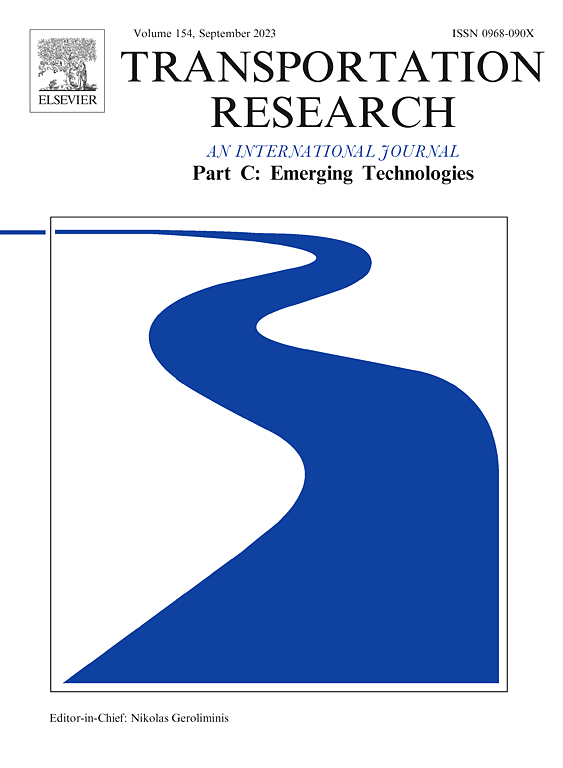Driving towards stability and efficiency: A variable time gap strategy for Adaptive Cruise Control
IF 7.6
1区 工程技术
Q1 TRANSPORTATION SCIENCE & TECHNOLOGY
Transportation Research Part C-Emerging Technologies
Pub Date : 2025-03-13
DOI:10.1016/j.trc.2025.105074
引用次数: 0
Abstract
Automated vehicle technologies offer a promising avenue for enhancing traffic efficiency, safety, and energy consumption. Among these, Adaptive Cruise Control (ACC) systems stand out as a prevalent form of automation on today’s roads, with their time gap settings holding paramount importance. While decreasing the average time headway tends to enhance traffic capacity, it simultaneously raises concerns regarding safety and string stability. This study introduces a novel variable time gap feedback control policy aimed at striking a balance between maintaining a minimum time gap setting under equilibrium car-following conditions, thereby improving traffic capacity, while ensuring string stability to mitigate disturbances away from the equilibrium flow. Leveraging nonlinear control technique, the strategy employs a variable time gap component as the manipulated control signal, complemented by a constant time gap component that predominates during car-following equilibrium. The effectiveness of the proposed scheme is evaluated against its constant time-gap counterpart calibrated using field platoon data from the OpenACC dataset. Through numerical and traffic simulations, our findings illustrate that the proposed algorithm effectively dampens perturbations within vehicle platoons, leading to a more efficient and safer mixed traffic flow.
向稳定和效率驱动:自适应巡航控制的可变时间间隔策略
自动驾驶汽车技术为提高交通效率、安全性和能源消耗提供了一条有前途的途径。其中,自适应巡航控制(ACC)系统作为当今道路上普遍存在的自动化形式脱颖而出,其时间间隔设置至关重要。虽然降低平均车头时距有利于提高通行能力,但同时也引起了对安全性和列车稳定性的担忧。本研究引入了一种新的变间隙反馈控制策略,旨在在平衡车辆跟随条件下保持最小间隙设置以提高通行能力,同时确保串稳定性以减轻偏离平衡流的干扰之间取得平衡。利用非线性H∞控制技术,该策略采用可变时间间隙分量作为被操纵的控制信号,辅以恒定时间间隙分量,在汽车跟随平衡中占主导地位。利用OpenACC数据集的野战排数据,对该方案的有效性进行了评估。通过数值和交通模拟,我们的研究结果表明,该算法有效地抑制了车辆队列内的扰动,从而实现了更高效、更安全的混合交通流。
本文章由计算机程序翻译,如有差异,请以英文原文为准。
求助全文
约1分钟内获得全文
求助全文
来源期刊
CiteScore
15.80
自引率
12.00%
发文量
332
审稿时长
64 days
期刊介绍:
Transportation Research: Part C (TR_C) is dedicated to showcasing high-quality, scholarly research that delves into the development, applications, and implications of transportation systems and emerging technologies. Our focus lies not solely on individual technologies, but rather on their broader implications for the planning, design, operation, control, maintenance, and rehabilitation of transportation systems, services, and components. In essence, the intellectual core of the journal revolves around the transportation aspect rather than the technology itself. We actively encourage the integration of quantitative methods from diverse fields such as operations research, control systems, complex networks, computer science, and artificial intelligence. Join us in exploring the intersection of transportation systems and emerging technologies to drive innovation and progress in the field.

 求助内容:
求助内容: 应助结果提醒方式:
应助结果提醒方式:


